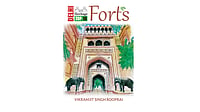Dark nights with a shiver in the wind. Bamboo thickets. Tamarind groves whispering. A huddle of villagers around a dying fire. Something white glimpsed vaguely in the gloom outside the comforting circle of light. And so the stories start...
‘The Dread of Night: Supernatural Encounters From the British Raj’ is a collection of supernatural stories written by two creative memsahibs during the British Raj. Both Bithia Mary Croker and Alice Perrin had links with India. Croker followed her husband to Madras and then to Bengal — she was stationed in the country for 14 years. Perrin was born in Mussoorie and lived most of her life in India with her husband.
Both Croker and Perrin wrote to relieve the boredom of life in British India for English memsahibs. Both were notable writers of ghost stories, apart from their perceptive commentaries on Anglo-Indian society. The stories were based on the world they saw every day, an India of dak bungalows, deserted bungalows in hill stations, creepy khansamas and khitmatgars, and do-or-die sportsmen — they recur time and again in ghost stories of British India but were very rarely visited from a feminine perspective.
Those interested in the vast pantheon of Indian ghosts may be disappointed. There are none of the demons and churails who haunt Indian villages and even spooked Jim Corbett. Instead, there are very human wraiths, a shapeshifter, and a cursed idol with appropriate supernatural sound effects.

Croker’s tales are gentler than Perrin’s with a subtle creep factor and on occasion the question of whether it is a ghost or a derangement arises. She deals with the souls of the restless dead looking for peace with a cast of lively Englishwomen coming to grips with a native environment. The settings are always rustic —hill stations, tea gardens, isolated, picturesque spots— and are always seen from the perspective of the women. Most of the spirits are those of murdered officials or women who succumbed to the diseases rife in an unfamiliar country and who can be dispersed through religious services which is actually what they are looking for. In a sense one could say that Croker uses her stories as a warning: the British who worked in the country came to unfortunate ends, murdered by resentful Indians and possibly the same fate awaits latter-day British residents who are forced by past incidents to leave the bungalows into which they have ventured.
Perrin’s stories carry the same message though her backgrounds are livelier. Many of her situations deal with sport and include runaway elephants and man-eating tigers. ‘Caulfield’s Crime’ centres on a shapeshifting fakir who punishes the armed white intruder who refuses to respect the swamplands’ customs. Her perspective of native Indians is rather more wary than Croker’s — she has them for the most part on the periphery of her stories. However, her memsahibs are less independent than Croker’s, travelling with their husbands and occasionally being bullied by them, caught in some kind of trap whether indoors or out — like the timid Netta in ‘Tiger’s Charm’ who is strengthened by a man’s compassion.
Both Perrin and Croker are wary of the native population, though Croker occasionally allows her characters to show compassion towards native women as in ‘If You See Her Face’. And of course, there are helpful old servitors willing to look after their memsahibs which makes for a contradiction but which was part of how Victorian writers in India saw the country.
Their interest in the livelier aspects of Indian life —the bustle on railway platforms or the chaos of hunts— is obvious. But for the most part, their lives consist of encounters with their own friends or neighbours, picnics, tennis matches, and gardening where Indians played a subordinate role on the outskirts of the organisation.
One could compare their accounts of society with Rumer and Jon Godden’s ‘Two Under the Indian Sun’ which evokes a genuine love for the chaos and colour of British India without cocking a snook at ‘noxious’ marigolds, Indian celebrations of Christmas or even at the habits of half-castes — though the latter are obviously forbidden friends unless they happen to be business associates.
(‘The Dread of Night: Supernatural Encounters From the British Raj’ is written by Bithia Mary Croker and Alice Perrin and is published by Speaking Tiger.)


























